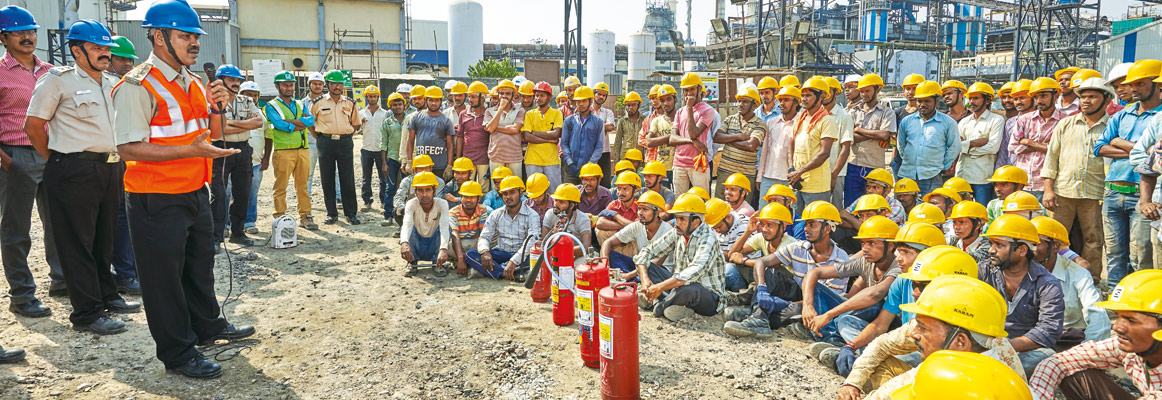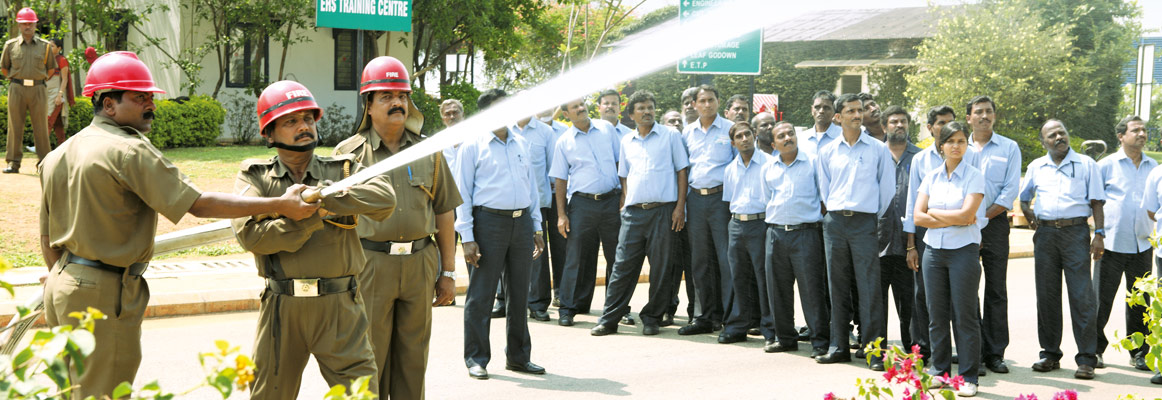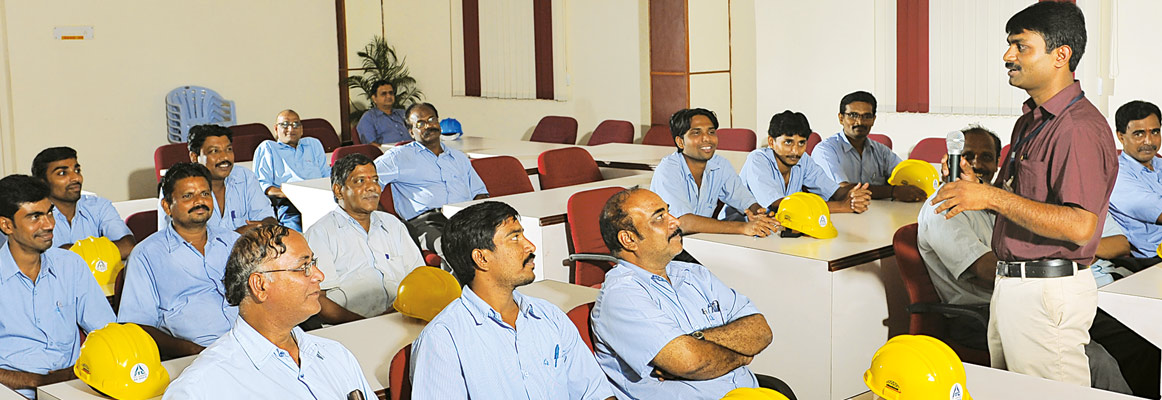 Environment
Environment Economic
Economic

ITC believes its workforce is a key asset contributing to the Company's long-term standing as one of India's most admired organisations. The Company believes that a safe and healthy work environment is a basic requirement for ensuring employee well-being and that best practices in occupational health & safety enhance the Company's overall performance. It helps in attracting and retaining quality talent, and also in enhancing the brand of the Company as a responsible Corporate. ITC ensures that Environment, Health and Safety (EHS) standards at all Units are continuously ahead of legislation and benchmarked with the best international practices and standards.
ITC's approach towards best-in-class occupational health and safety standards is articulated in the Board approved EHS Policy. It is based on an EHS management system which emphasises on continual improvement supported by continued investments in state-of-the-art technology and quality human resources.
ITC's journey in safety has evolved from 'compliance driven by standards and guidelines' to a 'behaviour centric - safety culture'. ITC believes that the positive transformation of employees' attitude and perception towards safety through inculcation of ownership would help ITC in its journey to achieve the goal of 'Zero Accidents'. Accordingly, behaviour based safety programmes have been initiated in manufacturing Units and Divisional Head Quarter (DHQ) of Paperboards and Specialty Papers Business.
ITC has identified the risk management framework as one of the integral steps towards building a robust safety management system. Accordingly, the risk assessment process involves the workforce to identify the risks in their operations, assess them and identify control measures that constitute the Safe Work Procedures (SWPs). Planned Job Observations (PJOs) and plant safety inspections enable the Unit/Management team to monitor the level of compliance and effectiveness of SWPs. Tailor made risk assessment workshops are conducted for the employees so that they can identify and assess risks on their own and develop control measures. Such interventions equip them to take individual ownership and enhance accountability of their actions.
Structured conversations are also carried out by employees with their peers and supervisors on Safe and Unsafe Acts (SUSA). These conversations are periodically reviewed and analysed to improve quality of engagement. This collaborative approach leads to positive behavioural change by reinforcing positive behaviour and correcting unsafe behaviour. This when repeatedly practiced, is expected to bring about the desired cultural change.
The key activities carried out to ensure robust EHS standards across all the stages are depicted below.
In ITC, on-site refers to the place of work i.e. factory, hotel, office, etc. which is under direct operational control of ITC. In 2016-17, the total number of on-site Lost Time Accidents (LTA) was 16 (against 18 in 2015-16). Out of these 16 accidents, 6 accidents occurred to ITC employees and balance 10 to the service providers' employees. All of these accidents occurred to male employees. There was one unfortunate fatal accident in 2016-17 to a service provider's employee who sustained burn injuries during a boiler start up.

Detailed investigations are carried out for all accidents, injuries, near misses and dangerous occurrences to identify the root causes. Further analysis of the root causes of the accidents have identified the need for strengthening the process of risk assessments and planned job observations and improvement in the supervision of service providers' employees. Accordingly, necessary corrective and preventive measures have been implemented across the Units.
Since 2012-13, ITC has started reporting safety performance of its service providers' employees working within ITC premises.
Loss Time Accident (LTA) is defined as accident due to which the injured does not return to work in the next scheduled shift. As can be seen from the following graph, total LTA (including service providers' employees) reflect a reducing trend despite a significant increase in number of manufacturing units and total employees.
Lost Day Rate (LDR) is defined as the number of man days lost due to accidents for every 2,00,000 man hours worked. As can be seen from the graph (on the next page), though there has been a drop in the LDR during 2016-17, it remains an area of concern and ITC is committed to continually improve upon this performance.
Injury Rate (IR) is defined as the frequency of LTA in relation to total time worked. Though there has been an improvement in the performance, it is of utmost concern that ITC still had a fatal accident in one of its factories. ITC accordingly, has been revalidating its entire approach to safety and is focused on creating a culture of safety across the Organisation.
In ITC, long-term agreements signed with Trade Unions include health and safety topics to encourage better participation and involvement from workers. During 2016-17, 3 long-term agreements with trade unions have been signed. Some of the health and safety topics that are included in the agreement are mentioned below:
The following ITC Units achieved 'Zero On-site Lost Time Accident' status in 2016-17.
Over the years, the number of Units delivering 'Zero On-site Lost Time Accident's performance has progressively increased and more importantly, have held on to their performance.
In ITC, off-site is defined as all places other than the premises where posted, which includes official duty and also commuting to and from residence to place of work. In 2016-17, the total number of off-site LTA was 30 (against 24 in 2015-16). Out of these 30 accidents, 25 were road accidents in which 17 accidents involved two-wheeler riders and 2 accidents involved four- wheeler users. There was one fatal road accident to an ITC employee while he was returning from work on his two-wheeler.
As a standard practice, off-site accidents are also investigated. The learnings from these accidents are disseminated across the Organisation and there is a constant reinforcement of the message to employees for exercising extreme care and being vigilant on the road.
The graph below shows Road Accidents Trend for ITC employees. The figures are on an increasing trend and this area remains a cause for concern.
Though road infrastructure and traffic management outside premises are well beyond ITC's control, ITC believes that improved awareness and adoption of 'defensive road safety techniques' helps reduce risks. ITC has accordingly initiated training and awareness sessions for its employees and supply chain members. Since over the years, majority of the road accidents have involved two-wheeler riders, a user interactive two-wheeler rider's safety programme was rolled out in 2011-12 for employees and in 2015-16, for ITC's Trade Marketing & Distribution (TM&D) supply chain members. The user interactive modules have been translated into vernacular languages to extend coverage and acceptance. During 2015-16, ITC also developed a similar user interactive training module for fourwheeler users.

A healthy workforce is an important contributor to ITC's competitiveness and sustainability. All Units maintain a conducive work environment meeting Indian/International standards on hygiene, lighting, ventilation and effective controls on noise and dust. Units are provided with occupational health centres with adequate medical staff to monitor occupational health and provide immediate relief, when required. In addition, at least 2% of total employees are professionally trained as first aiders.

As part of ITC's preventive medical programme, various categories of employees based on age and exposure to occupational hazards undergo periodic medical check-ups. Accordingly, in 2016-17, 12,892 employees underwent preventive medical examinations and there were no occupation related illnesses identified in any of ITC's Business Units.
ITC remains committed to protecting its employees from the threat posed by various serious diseases including HIV/ AIDS, hepatitis, dengue, malaria etc. During 2016-17, the awareness/counselling sessions conducted for the employees and communities around ITC's Units covered a total of 9,790 people, out of which 6,872 were employees of the Company, while the remaining were local community members. Awareness sessions are also conducted regarding the other off-the-job safety aspects such as home safety and safe use of LPG in kitchen and road safety.
In line with the Company's EHS policy, the approach is to institutionalise safety as a value-led concept with focus on inculcation of ownership at all levels, leading to the creation of a cohesive safety culture. Periodic reviews are undertaken to ensure that training and other communications are relevant and take into account the local socio-economic context to ensure the transition from 'awareness developed' to 'changed behaviour'.
ITC will continue to take efforts to create a safe working environment and strong safety culture through the following interventions.
ITC will continue to evaluate its safety performance through requisite mix of leading and lagging indicators and course correct accordingly. The objective remains to achieve 'Zero Accident' status in the coming future.